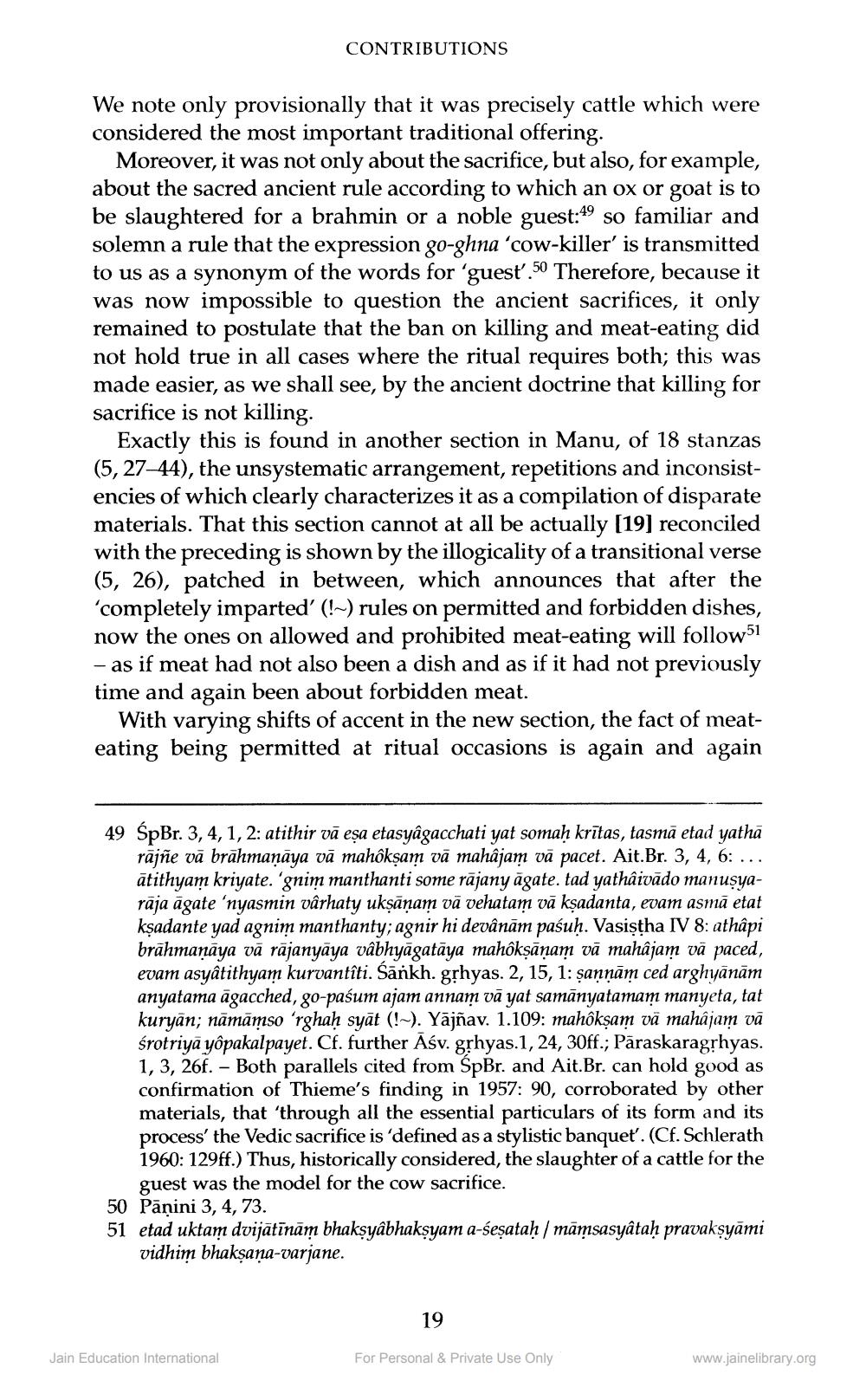________________
CONTRIBUTIONS
We note only provisionally that it was precisely cattle which were considered the most important traditional offering.
Moreover, it was not only about the sacrifice, but also, for example, about the sacred ancient rule according to which an ox or goat is to be slaughtered for a brahmin or a noble guest:49 so familiar and solemn a rule that the expression go-ghna 'cow-killer' is transmitted to us as a synonym of the words for 'guesť. 50 Therefore, because it was now impossible to question the ancient sacrifices, it only remained to postulate that the ban on killing and meat-eating did not hold true in all cases where the ritual requires both; this was made easier, as we shall see, by the ancient doctrine that killing for sacrifice is not killing.
Exactly this is found in another section in Manu, of 18 stanzas (5,27-44), the unsystematic arrangement, repetitions and inconsistencies of which clearly characterizes it as a compilation of disparate materials. That this section cannot at all be actually (19) reconciled with the preceding is shown by the illogicality of a transitional verse (5, 26), patched in between, which announces that after the 'completely imparted' (!~) rules on permitted and forbidden dishes, now the ones on allowed and prohibited meat-eating will follow51 - as if meat had not also been a dish and as if it had not previously time and again been about forbidden meat.
With varying shifts of accent in the new section, the fact of meateating being permitted at ritual occasions is again and again
49 ŚpBr. 3, 4, 1, 2: atithir vā esa etasyâgacchati yat somaḥ krītas, tasmā etad yatha
rajñe vā brāhmaṇāya vā mahôkşam vā mahājam vā pacet. Ait.Br. 3, 4, 6: ... ātithyam kriyate. 'gnim manthanti some rājany ägate. tad yathậivādo manusyarāja āgate 'nyasmin vârhaty ukṣāņam vā vehatam vā kşadanta, evam asmā etat kşadante yad agnim manthanty; agnir hi devânām paśuḥ. Vasiştha IV 8: athậpi brāhmaṇāya vā rājanyāya vâbhyāgatāya mahôkşānam vā mahâjam vā paced, evam asyâtithyam kurvantîti. Sankh. grhyas. 2, 15, 1: sannām ced arghyānām anyatama āgacched, go-paśum ajam annam vā yat samānyatamam manyeta, tat kuryān; nāmāmso 'rghaḥ syāt (!-). Yājñav. 1.109: mahôkşam va mahâjam vā śrotriyā yöpakalpayet. Cf. further Aśv. gļhyas.1, 24, 30ff.; Pāraskaragshyas. 1, 3, 26f. - Both parallels cited from SpBr. and Ait.Br. can hold good as confirmation of Thieme's finding in 1957: 90, corroborated by other materials, that 'through all the essential particulars of its form and its process' the Vedic sacrifice is 'defined as a stylistic banquet'. (Cf. Schlerath 1960: 129ff.) Thus, historically considered, the slaughter of a cattle for the
guest was the model for the cow sacrifice. 50 Pāṇini 3, 4, 73. 51 etad uktam dvijātīnām bhaksyabhaksyam a-beşatah / māmsasyâtah pravaksyāmi
vidhim bhakşaņa-varjane.
19
Jain Education International
For Personal & Private Use Only
www.jainelibrary.org




